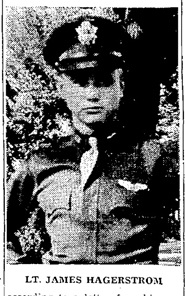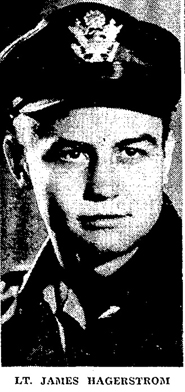Lieut. James P. Hagerstrom, fighter pilot with the U. S. army air corps, has arrived safely overseas, according to a cablegram received Friday evening by his parents, Mr. and Mrs. E. R. Hagerstrom, 915 Western avenue.
Two other brothers are also in the U. S. Army.
Pfc. Robert C. Hagerstrom is stationed with the air corps at Gardner field, Taft, Cal., and Pvt. E. Russell Hagerstrom is stationed at Fort Lewis, Wash.
Source: Waterloo Daily Courier, November 29, 1942
![]()
Hagerstrom Gets Second Cluster
First Lt. James P. Hagerstrom, son of Mr. and Mrs. E. R. Hagerstrom, 915 Western avenue, has been awarded a second Oak Leaf Cluster “for meritorious achievement” while participating in 25 operational flights in the southwest Pacific area during which hostile contact was expected, according to word received from the headquarters of Lt. General George C. Kenney, commander of the Allied air force in the southwest Pacific.
The Cluster is in addition to a previous award of the air medal and Oak Leaf Cluster and is equivalent to having won that decoration a third time.
Lieutenant Hagerstrom is with a fighter squadron of the Fifth Air Force.
Source: Waterloo Daily Courier, November 14, 1943
![]()
Hagerstrom Has Big Day Against Nips
Lt. James P. Hagerstrom of Waterloo, at present of the South Pacific, had what many fliers would call “field day” recently on a mission over a “certain Japanese base,” according to a letter from him received by his parents, Mr. and Mrs. E. R. Hagerstrom, 915 Western avenue.
“The boy flying my wing (Lt. Bodak) helped me out by knocking a Jap off my tail at a most opportune time,” Lieutenant Hagerstrom wrote.
“I in turn shot one off his tail—a good time was had by all. My unofficial score was four definite fighters bagged, two fighters probably destroyed and two or three fighters damaged.
“We escaped without even a bullet hole.”
The Waterloo pilot has been in the South Pacific 15 months and on Jan. 22, he logged his 150th mission, making his total 300 combat hours. He had a Jap Zero and a twin-engined bomber to his credit previously.
Two brothers also are in service. One, Cpl. E. R. Hagerstrom Jr., is a dog trainer in Camp Adair, Ore., and the other, Lt. E. C. Hagerstrom is on his way to the South Pacific in a B-25 bomber, it is thought.
Source: Waterloo Daily Courier, March 5, 1944 (photo included)
![]()
Air Heroes Hagerstrom and Ludtke Enjoy Visit at Home.
Two young Waterloo lieutenants of the army air forces, who have been helping to win the war against Japan during 18 months overseas, were back home in Waterloo Saturday.
They are:
Lt. James P. Hagerstrom, 23, son of Mr. and Mrs. E. R. Hagerstrom, 915 Western avenue.
Second Lt. Robert E. Ludtke, 24, son of Mr. and Mrs. H. G. Ludtke, 715 Hammond avenue.
In their respective duties of combat and reconnaissance both boys have distinguished themselves. Into their 18 months of overseas duty was crowded more tense action than usually comes to men in a lifetime. Yet, when they got up at 2 a.m. to catch the first glimpse of the Golden Gate, as their ship approached San Francisco, they were two boys yearning for a sight of the home land.
Started Together.
They had gone to grade school and high school together and after serving their country’s cause in the air force. It was their good fortune to come home together on the same boat.
When they were in school together, Ludtke says, he never anticipated that one day a lieutenant general would pin a Distinguished Flying Cross on his chest nor did Hagerstrom ever dream that he would be an American flying ace at the age of 24.
Both Hagerstrom and Ludtke have been awarded Distinquished Flying Crosses and the Air Medal.
In addition to the D. F. C., and the Air Medal, Hagerstrom has won four Oak Leaf clusters and a citation.
Lieutenant Ludtke, a photographic reconnaissance pilot, has been awarded the Distinguished Flying Cross, the Air Medal and the Soldier’s Medal.
The Soldier’s Medal, which is awarded for heroism not involving conflict with the enemy, was won by Ludtke for saving the lives of four members of the crew of a bomber that crashed near where he was stationed in New Guinea.
“It was about 5 a.m. that I was awakened by a plane crash,” Ludtke related in an interview at the home of his parents.
All Four Lived.
He continued:
“The plane had cracked up on the takeoff. It was a mile away. I got out of bed and drove a jeep to where the plane was burning in a swamp. I managed to pull four men out of the plane. Yes, it was plenty hot. There were two reporters killed in the crash. One was from the London Times and the other from the Brisbane Telegraph. One of the reporters had been wanting to get to the front and at last he had got his chance. The four that I was able to pull out of the wreckage survived.”
Lieutenant Ludtke has been on 93 photographic reconnaissance missions in the New Guinea area.
His unit, the Eighth photographic squadron, has received the presidential citation for outstanding performance of duty.
Speaking of the P-38, which he flies, Lieutenant Ludtke said:
“They are faster than anything else and they need to be, because we are up there all alone. I’ve been over all of the enemy bases in that area, sometimes on missions as far as 1,000 miles.”
Lieutenant Ludtke continued:
“It worries you a little bit to know that there’s someone down there trying to get you. I’ve seen a lot of ack-ack, but it’s not very accurate.
“In nearly every mission, I get pictures of enemy airplanes, but my plane is so fast that I can get away before they get up.
Navigation Important.
“I went through a daylight raid last April on the ground in New Guinea. There were more than 100 Jap planes overhead. All of the bombs dropped on our strip, a little too close. I could see bombs exploding all around. They make a sort of swishing sound before they hit. The only protection was to get into a slit trench.”
Navigation plays a big part in reconnaissance flying.
Lieutenant Ludtke has 275 flying hours to his credit in the completion of 93 missions, during his time overseas.
Flying was Ludtke’s childhood ambition. His father relates that Robert always had stacks of airplane magazines around the house when he was a boy and was enthusiastic about making model airplanes when he was a youngster.
Asked what a fighter pilot thinks about while in action, Lieutenant Hagerstrom said:
“You are scared and your heart beats like hell; outside you are calm, but you are scared worse than death.”
When one of their buddies fails to come back from combat the others feel badly but, “there is no emotion like is shown in the movies,” Lieutenant Hagerstrom said. “They just say, ‘Tough luck’.
“You can’t let it get you—you get accustomed to it.”
Lieutenant Hagerstrom has 170 combat missions and 350 combat hours to his credit.
He Bagged Four.
He described one engagement on last Jan. 23 over Wewak, New Guinea.
“We were in P-40’s, escorting heavy bombers, B-24’s the Jolly Rogers outfit. We received radio messages from our P-38’s, that there were 60 Zeros overhead. I got into the fight and helped out the P-38’s. I got four definites and two probable’s that day. My wing man, John Bodak, got two definites and one probable.
“We had to fight our way out. If we hadn’t run out of ammunition, we’d be there yet.”
Lieutenant Hagerstrom related that sometimes they went on as many as four missions a day.
“There is hardly any noise audible during combat. You have a headset and goggles. What you hear mostly is radio communication.”
Once his plane crashed one-half mile within the Allied lines.
“Were you hurt?” he was asked.
“Just shaken up,” he said.
Unit Wins Citation.
The unit with which Lieutenant Hagerstrom serves, the Eighth squadron of the Forty-ninth fighter group was awarded the presidential citation for outstanding performance of duty in action during the period from Mar. 14, 1942, to Aug. 25, 1942.
This unit, although greatly outnumbered by enemy aircraft, boldy intercepted it on every attempted attack and extracted toll far out of proportion to its vicinity, he wrote the word, “boat” on the sand bar. The planes tossed supplies to him, including a boat. He floated down the river for two days.
The citation was ordered by the secretary of war and signed by Gen. Geo. C. Marshall.
Another letter of congratulations received from Edwin A Doss, major in the air corps and endorsed by Paul B. Wurtsmith, brigadier general, commanding expressed “appreciation of the fine work done by the Eighth fighter squadron, while assigned to this group at Tatli Taili, having successfully fulfilled every mission. The letter added that the “concerted and determined effort of this unit inspired all troops in that area.”
The group to which Lieutenant Hagerstrom is attached has a record of 151 enemy airplanes definitely shot down with only 14 of their own planes lost, including five fliers killed and two missing.
Four hundred and twenty-five airplanes have been destroyed on the ground by this group, which took part in the capture of Lei. This outfit has credit for 25 enemy fighter pilots shot down in air combat. Their old group commander is now in general command of the Fifth air force.
“We received an official order from General Hap Arnold to remember those American boys, who were executed for bombing Tokyo, every time we got a Zero in our sights,” Hagerstrom related.
“I don’t think anybody feels bad when shooting them now,” he added.
“Yes, I shot down six Zeros after that order.”
By so doing, Lieutenant Hagerstrom, qualified as an ace, as the shooting down of five enemy airplanes entitles a pilot to that designation.
After a few months, Lieutenant Hagerstrom wants to go back and fly a P-51 or Mustang as it is called, the “best fighter there is,” as he terms this type of plane.
Following their three weeks leave in Waterloo, Lieutenant Ludtke and Lieutenant Hagerstrom will report to Miami, Fla., for reclassification.
Did it seem good to get home?
Here is the way they described it:
“When we saw the lights of San Francisco, it gave us a feeling that is hard to describe. We didn’t smile. But it just seemed that inside we had a sort of a glow.”
Source: Waterloo Sunday Courier, March 26, 1944 (photo included)
![]()
City Has Five on Hero List From Pacific
Among those listed in an Associated Press dispatch Monday as flying heroes of the second year of war in the southwest Pacific theater were five Waterloo airmen and a sixth from Cedar Falls.
On the Waterloo list were:
Lt. Churchill T. Williams
Lt. James P. Hagerstrom
Lt. George R. Fisher, Jr.
Lt. Robert E. Ludtke
Capt. James W. Selzer.
The Cedar Falls flier honored was Capt. Roy W. Olsen.
Lieutenant Williams is holder of the Silver Star for gallantry in action. Lieutenant Hagerstrom has been awarded the Distinguished Flying Cross for heroism and extraordinary achievement.
Lieutenants Ludtke and Fisher and Captain Selzer were listed as receiving the Air Medal for meritorious achievement.
Captain Olsen’s award was the Legion of Merit.
The story relates that more than 110 medals have been awarded to Iowans in the southwest Pacific theater, with the recipients accounting for 11,000 hours of combat flying.
Source: Waterloo Daily Courier, April 17, 1944
![]()


